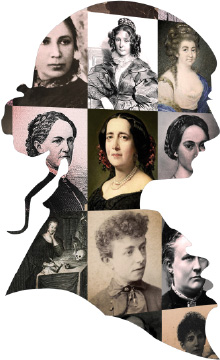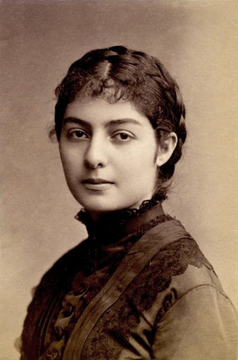Kraljica Natalija Obrenović
1859–1941| Spouse | Milan Obrenović |
|---|---|
| Other names | Natalija Petrovna Keško |
| Date of birth | May 14, 1859 |
| Date of death | 1941 |
| Web address |
Personal situation
1859 - Natalija Petrovna Keško was born on May 14, 1859, in Florence. She was of Russian-Moldovan origin. Her father was originally from Russia and a mother from Moldova. She lost her father at the age of six, and her mother died when Natalija was fifteen. After her mother's death, Natalija stayed with her brother and her two sisters in Russia. She graduated from a girls' boarding school for daughters of aristocrats in Paris.
1875 - When she was seventeen, Natalija got engaged with Prince Milan Obrenović. They got married in Belgrade on October 17. The following year, Prince Aleksandar Obrenović was born. The second son of Milan and Natalija, Sergije, died shortly after birth.
1882 - Serbia became a kingdom, and Princess Natalija became The Queen.
1887 - 1889 - Due to Milan's leisurely life, gambling and numerous infidelities, the King and the Queen began to distance themselves from each other. Their characters were different, as well as the attitudes toward government duties. In other words, while the Queen was responsible and tough, the King often showed irresponsibility and a lax attitude towards the authorities. Also, Queen Natalija was in favor of Russia, and King Milan relied on Austria. Numerous disputes led to the King's 1887 demand that the Queen leave Serbia, after he realized that she could jeopardize his position and political influence. The agreement was that the Queen was entitled to spend the summer in Serbia, but then she had to leave the country for a year. In 1888, after Natalija's return to Serbia, Queen Natalija and King Milan officially got divorced. After the final break with the King, the Queen moved to Biarritz in the villa "Sašino". During exile, she saw her son Aleksandar only occasionally. Since King Milan abdicated in 1889 and left Serbia, she returned to the country.
1891 - 1895 - In May 1891, Queen Natalija was expelled from Serbia. When King Aleksandar came to power in 1893, she refused to return to Belgrade. Only two years later, i.e. in 1895, she returned to Serbia. She lived in the country only when King Milan was absent.
1900 - Occasionally, she would return to Serbia to meet her son. However, realizing that King Aleksandar fell in love with her court lady Draga Mašin, she tightened her relationship with her son. Queen Natalija strongly opposed her son's marriage with Draga Mašin. But in spite of the opposition of his mother, many friends, and politicians, in 1900, King Aleksandar married Draga Mašin.
1902/1903 - Queen Natalija converted to Catholicism in 1902 and did not return to Serbia anymore. She gave her property to the University of Belgrade, and not to her son. In 1903, her son, King Aleksandar Obrenović, and Queen Draga Mašin were killed, and the Karađorđević dynasty came to power in Serbia.
1914 - 1918 - During the First World War, Queen Natalija helped the Serbian people. After the war, she lived in Paris in a women's monastery. In Paris, the former Serbian queen lived in seclusion and poverty, which was publicized by the world press.
1941 - She died in Paris in great poverty.
| Place of birth | Firenca |
|---|---|
| Place of death | Pariz |
| Nationality | Russo-Moldavian |
| First language(s) | French and Russian |
| Marital status | Divorced |
| Number of children | 2 |
| Name(s) of children | Aleksandar, Sergije |
| Gender of children | M (2) |
| Social class | Royalty |
Professional situation
Queen Natalija worked on the emancipation of women in Serbia. She participated in the creation of Domaćica (The Housewife) magazine in 1879. She was the founder of the Women's Association for National Homework, and also sponsor of the Higher School for Women.
Queen Natalija actively participated in the government work, often opposing her husband and his ideas, above all his affection for Austria. The divorce of the King and the Queen had a major influence on the political scene in Serbia. In other words, the politicians who supported Queen Natalija and who were her friends were at the same time the enemies of the King and vice versa. Some people, like General Belimarković, Milutin Garašanin and Jovan Ristić, turned their back on her after her official divorce with King Milan.
In 1885, the Queen published a translation from Russian into Serbian Umna borba u Rusiji (Mind Struggle in Russia) by author Ivan Pavlov.
Sources:
Đurić, Đorđe, "Karakteristični srpski intelektualac između dva kralja i dve kraljice iz dinastije Obrenović." Zbornik Matice srpske za istoriju (2008): 215-224.
Trgovčević, LJubinka (predgovor) u: Kraljica Natalija Obrenović. Moje uspomene. Beograd: Srpska književna zadruga, 2006, str. 19-46.
Savremenici i poslednici Dositeja Obradovića i Vuka Stefanovića Karadžića sakupio, obradio i sredio Vlastoje D. Aleksijević (1911–1969); Osma sveska: slova NJ-O;
Available on: http://digitalna.nb.rs/wb/NBS/Katalozi_i_bibliografije/P_425/P_425_08#page/0/mode/1up
Chronology and bibliography edited by Milica Đuričić
Translated by Marija Bulatović
| Profession(s) and other activities | cultural and educational patron, politician, and translator |
|---|---|
| Language(s) in which she wrote | French and Russian |
Works by this author
Monographs
- Mati i sin 1892
- Aforizmi kraljice Natalije 1897
- Pisma kraljice Natalije Obrenović 1996
- Moje uspomene 1999
- Ruža i trnje: uspomene, aforizmi i priče, pisma 2015
Translations
- Umna borba u Rusiji 1885
Reception
Reception during lifetime
- Kraljica Natalija (1889)
- Kraljica Natalija (1891)
- Pripovetke kraljice Natalije (1897)
- A Kingʹs Romance: the story of Milan and Natalie first king and queen of Servia: with numerous portraits and other illustrations (1903)
- Srpska kraljica Natalija Obrenović (1905)
Reception after death
- Kraljica Natalija Obrenović: žena kralja Milana Obrenovića (1859-1941) (1998)
- Priča jedne kraljice (1999)
- Natalija (1999)
- Nathalie de Serbie: la reine errante (2000)
- Moje uspomene (sećanja kraljice Natalije Obrenović) (2000)
- Kraljica Natalija Obrenović: Moje uspomene, priredila Ljubinka Trgovčević (2000)
- Pripovetke kraljice Natalije Obrenović (2003)
- Natalija Obrenović: majka poslednjeg kralja dinastije (2006)
- Kraljica Natalija i Rusija - od razvoda do preveravanja (2013)
- Hronologija života i rada kraljice Natalije Obrenović (2015)
- Roman o piscu i kraljici (2015)
- Roman kraljice Natalije (2015)
- Značaj književnih radova kraljice Natalije (2015)



